There are countless websites that offer educational resources for people of all ages. Many of them are easy to find through your favorite search engine and also free to use. However, there are disadvantages to many of them, such as:
- While "free" means you don't have to pay actual money for them, in most cases they still require you to give up some of your privacy (thanks to targeted advertisements).
- You need access to the internet whenever you want to use them.
- Their underlying code is proprietary, which means no one except the author(s) can modify them to fix bugs or improve the user experience.
- Because they are proprietary, you have to accept any changes made to their design, no matter how sudden, and even if you don't particularly like them (unless the authors are willing to listen to user feedback).
This is an overview of some of my favorite KDE applications that are specifically made for people who would like to learn new skills or cultivate existing ones. All of them are free software (not just gratis, but free as in freedom, just like everything that is part of KDE), and they can be installed on your computer running GNU/Linux (even if you use a desktop environment other than KDE Plasma) so that you can access them offline anytime.
KTouch
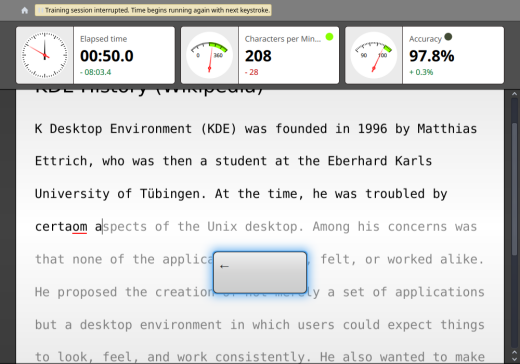
KTouch with an excerpt from the Wikipedia article on KDE.
KTouch is a tool that helps you learn and practice touch typing, which not only makes you a faster typist (since you won't have to stop typing now and again to look at your keyboard) but is particularly useful when you work with the text editor Vim (or any other editor that supports Vim key bindings).
In KTouch, you can select a built-in lesson or add custom lessons where you decide what text you would like to practice typing. During the lessons, you type the text as quickly and as accurately as you can. To pass a lesson, you must achieve a speed of 180 characters per minute and an accuracy of 98%, both of which can be monitored in real time at the top of the window. If you make a mistake, you have to go back (the typo is automatically underlined and an illustration of the backspace key appears as a hint) and correct it before you can continue. When you're done, KTouch provides statistics on your performance, which you can compare to earlier attempts.
While overall I had a great experience with this program, I did find a few minor quirks. For example, built-in courses show up on the homescreen only if you've selected a keyboard language layout that is the same as an available course. Also, I had to make sure I selected Wrap lines automatically when I added a custom lesson to make the text large enough to be legible. But other than that, I think KTouch does a remarkable job at tutoring you in touch typing.
KGeography
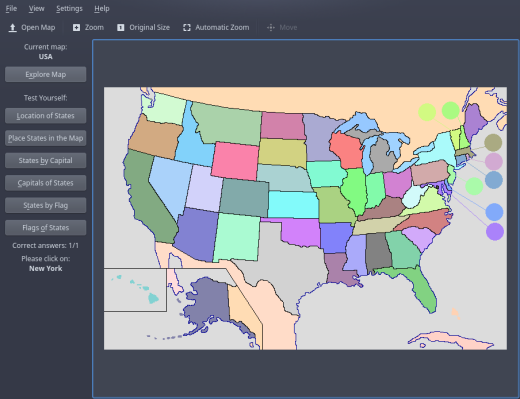
KGeography
If you need to memorize the names or locations of various countries, their political divisions, capitals, and flags, KGeography can be very helpful. It comes with a world map with all of the countries, a map of each continent, maps of most countries, and multiple types of exercises. At the end of each exercise, you can review your results. It's a relatively simple but clever tool!
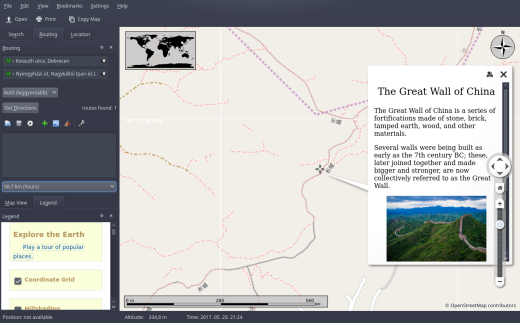
Marble
Marble
For additional geography study, there's Marble. Probably the easiest way to describe Marble would be to compare it to Google Earth: You can browse different types of Earth maps (including a global roadmap and topographical, historical, and weather maps), plan routes, track locations, and view information about points of interest on Wikipedia. However, the most striking differences are that all maps have a Creative Commons license or are in the public domain (e.g., created by the OpenStreetMap project or NASA) and, of course, Marble is free as in freedom.
Minuet
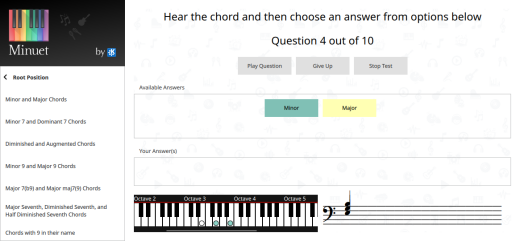
Minuet
Minuet is music-education software containing many exercises for sharpening your skills in recognizing chords, intervals, rhythms, and scales. Each exercise involves listening to a sample and selecting the right solution based on what you hear. As you hover your mouse cursor on an answer, visual representations of the sample are shown on a virtual piano keyboard and a music sheet.
According to the application's official website, Minuet also features a MIDI player, although I can't find it anywhere. But even with just the exercises, it's a nice way to enhance your listening skills.
KWordQuiz

KWordQuiz
KWordQuiz allows you to create virtual flashcards with two sides, each containing a piece of text that's related to the another. For example, if you want to memorize the meaning of words in a foreign language, you could write a word on one side and its translation in your mother tongue on the other. Or if you're preparing for a history exam and need to memorize historical dates, you could write the date on one side and an explanation of the related event on the other side. You can even add images and audio to your cards to enhance your learning.
After you've created your cards, you can choose between three different modes: flashcard (which allows you to indicate whether or not you know what's on the other side), multiple choice, and question & answer (where you type in your answer). In addition, you can specify which sides you want prompts on as well as whether you want the cards to be shown in a specific order or randomly. Also, you can set different keyboard layouts per side when typing your answers (very helpful when you're studying a foreign language).
While I like what KWordQuiz offers, there are two features I think are missing: spaced repetition and a homescreen showing all your card decks. For filling these gaps, Parley, another KDE software, would be ideal, but I found it way too buggy to be suitable for everyday use. I recommend Anki instead if you need more from a flashcard app than what KWordQuiz offers.
More from KDE
If you like the educational software mentioned in this article and would like to know about other software with similar goals, check out the list on the KDE website.

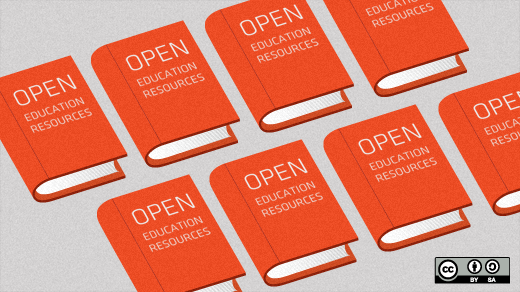





2 Comments